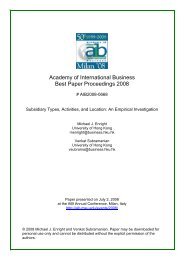AIB 2012 Conference Proceedings - Academy of International ...
AIB 2012 Conference Proceedings - Academy of International ...
AIB 2012 Conference Proceedings - Academy of International ...
You also want an ePaper? Increase the reach of your titles
YUMPU automatically turns print PDFs into web optimized ePapers that Google loves.
MONDAY<br />
opportunities and challenges as framed by top management mental models. The punctuated equilibrium model<br />
was not supported. Greiner's (1972) approach may, at the least in the first phases, contribute to explain BG<br />
development. BGs face transitions that entail significant changes in the way how business is understood and<br />
how the company is organized. However, the result from the transition is not fully congruent archetype as<br />
Ambos and Birkinshaw (2010) suggested. Another important contribution is the finding that some prefoundation<br />
features do persist for more than twelve years after company creation, namely the international<br />
commitment. (For more information, please contact: Vítor Corado Simões, ISEG, Technical University <strong>of</strong> Lisbon,<br />
Portugal: vcs@iseg.utl.pt)<br />
The New Argonauts, <strong>International</strong> New Ventures and Performance Implication<br />
Guohua Jiang, Temple University<br />
Masaaki Kotabe , Temple University<br />
<strong>International</strong> new venture (INV) is an important topic for scholarly inquiry in international entrepreneurship<br />
literature. A new venture with an ethnically diversified founding team could leverage international experience<br />
and network <strong>of</strong> each <strong>of</strong> its founders, thereby, influencing its recognition <strong>of</strong> opportunities and access to<br />
resources to pursue internationalization strategy. This study explores the effect <strong>of</strong> founding ethnic composition<br />
on a new venture's internationalization strategic choice. Then, we study the performance implication <strong>of</strong> new<br />
ventures. We test hypotheses using longitudinal data <strong>of</strong> 4,928 new ventures in Kauffman Firm Survey. It is<br />
found that more immigrant entrepreneurs are more likely to pursue INV strategy while more US citizen<br />
entrepreneurs will pursue domestic new venture (DNV) strategy. Furthermore, INV has higher revenues than<br />
DNV but there is no difference in pr<strong>of</strong>its between them. Finally, a new venture is established with the<br />
entrepreneur's initial knowledge; while it is required to acquire and develop additional organizational technology<br />
knowledge. Both are important for new venture performance. (For more information, please contact: Guohua<br />
Jiang, Temple University, USA: tua63885@temple.edu)<br />
An <strong>International</strong> Ambidexterity Model to Understand New Venture <strong>International</strong>ization and Growth<br />
Fiona Xiaoying Ji, Kean University<br />
Devi R. Gnyawali, Virginia Polytechnic Institute and State University<br />
Donald E. Hatfield, Virginia Polytechnic Institute and State University<br />
Firms use international operations to access external resources to exploit existing competences or explore new<br />
market or technological knowledge; however after initial internationalization at a young age, international new<br />
ventures might choose to go to similar foreign markets to leverage and exploit existing knowledge for growth or<br />
they might continue experimenting with less related foreign markets. In this study, we propose that<br />
international new ventures benefit from using an ambidextrous strategy for long-term performance employing<br />
both exploitation and exploration. Using a sample <strong>of</strong> 311 international new ventures to test our hypotheses, we<br />
found that the benefits associated with international exploration through early internationalization are realized<br />
when a firm continues further commitment to exploitation capabilities so they can accomplish ambidexterity<br />
learning from narrower scope <strong>of</strong> international expansion. (For more information, please contact: Fiona Xiaoying<br />
Ji, Kean University, USA: xji@kean.edu)<br />
Session: 2.4.12 - Interactive<br />
Track: 13 – Teaching IB<br />
<strong>International</strong>izing and Enriching the Business Curriculum<br />
Presented On: July 2, <strong>2012</strong> - 14:30-15:45<br />
Chair: Vinod K Jain, University <strong>of</strong> Maryland, College Park<br />
<strong>AIB</strong> <strong>2012</strong> <strong>Conference</strong> <strong>Proceedings</strong><br />
Page 176

















